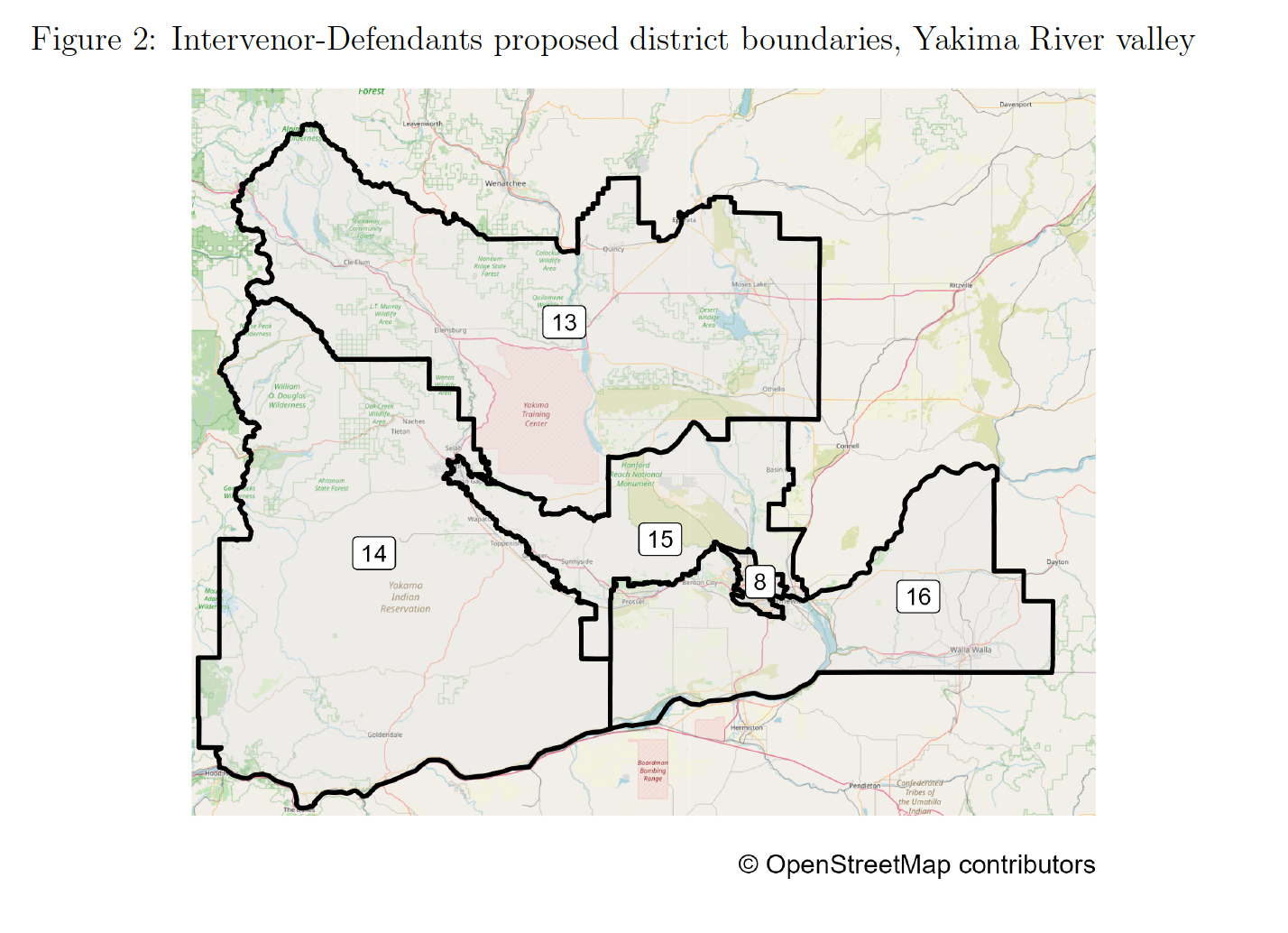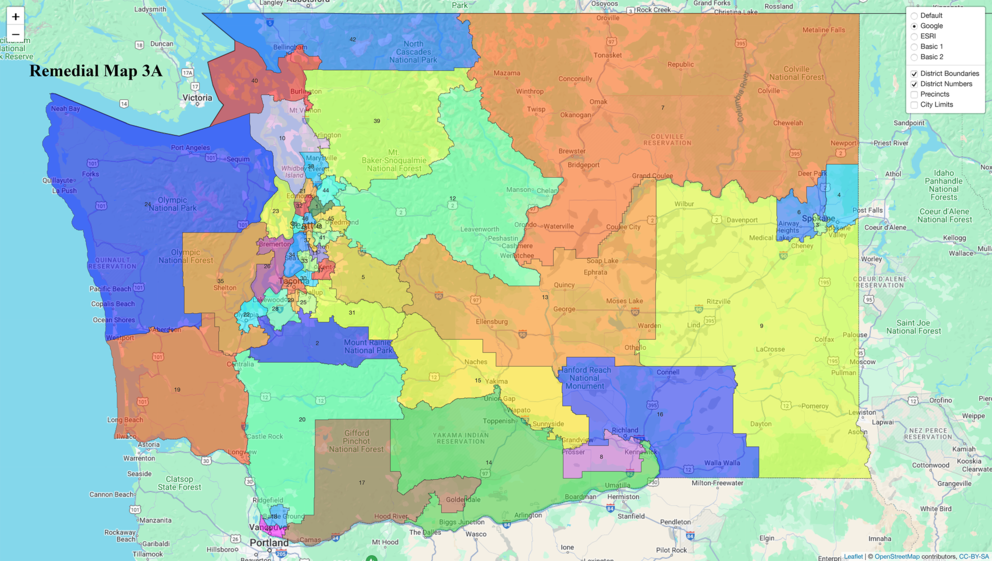At a Friday hearing in U.S. District Court in Seattle, attorneys discussed the merits and deficits of one of five proposed maps — known as Remedial Map 3A — to establish a Latino-majority district that aligns with federal voting laws. An expert retained by conservative Latino voters intervening in the case also spoke about their preferred alternative map.
In August, Lasnik ruled that the 15th Legislative District in Central Washington, as drawn by the Washington State Redistricting Commission in 2021, diluted voting power for Latinos in the region, siding with plaintiffs in the case, known as Palmer v. Hobbs.
The federal court is now overseeing the map redrawing process after state legislators — primarily Democratic leaders — decided not to reconvene the state’s bipartisan redistricting commission.
The court has until March 25 to approve and transmit a new map to the Secretary of State’s Office to give election officials plenty of time to use the new boundaries for the 2024 Election. Their first deadline is the filing period for candidates in early May.
“I will digest what happened here today, get revised updated maps … and we will endeavor to get a decision out by a week from [last Friday, March 8], understanding that our Secretary of State needs an absolute answer [in] a week or a little later,” Lasnik said at the end of the hearing.
During a previous hearing in February, Lasnik indicated he was leaning toward Remedial Map 3A. He preferred that map not only because it included a Latino-majority district — Legislative District 14 — that unites Latino population centers from East Yakima in Yakima County to Pasco in Franklin County but also because it keeps the Yakama Nation Reservation in one district, also the 14th.
The judge’s preferred map was a revision of Remedial Map 3A. While the boundary of the Latino-majority district was the same in both maps, the boundaries of neighboring districts in Remedial Map 3A were adjusted to decrease the number of incumbent Republican legislators displaced.
While all the land within Yakama Nation Reservation boundaries is in the same district, Yakama Nation officials have asked the court to also include in District 14 all the tribe’s off-reservation lands and fishing sites in Klickitat County, as they were in the redistricting commission map.
Yakama Nation leaders have not voiced an opinion on Remedial Map 3. During the hearing, Anthony Aronica, senior attorney for the Yakama Nation, said tribal leaders supported the map that resulted from the original 2021 redistricting process. Aronica said the tribe's priorities from 2021 remain the same: to preserve the integrity of Yakama Nation Reservation boundaries and to also include, as much as possible, off-reservation lands and fishing sites along the Columbia River, in the same district.
Kassra A.R. Oskooii, a University of Delaware professor involved in drawing the plaintiffs’ proposed maps, indicated that most of those lands are within the same district. However, one of the fishing sites is currently not in the district to ensure the district’s population is equal to others. He notes that even though the district doesn’t include all those sites, the number of voter-eligible Native Americans in Legislative District 14 is higher than in the map drawn by the Washington State Redistricting Commission.
During the hearing, conservative Latino voters who intervened in the case continued to voice concerns with Remedial Map 3A. Among those intervening is State Rep. Alex Ybarra, a Latino legislator from Quincy in the neighboring 13th Legislative District. House Republican Leader Drew Stokesbary is serving as counsel for the conservative voters.
The intervenors have made several efforts to halt the map redrawing process. They maintain that the plaintiffs’ action was an attempt to get Democrats elected in a conservative region, and have appealed Lasnik’s ruling from August. One recent appeal attempt was unsuccessful — the U.S. Supreme Court declined to hear their case. However, the U.S. Court of Appeals case remains active. Intervenors said in a court filing with the U.S. Court of Appeals that it now hopes to go through a combined appeal of both the ruling and of whatever map is chosen.
The appeals court approved the intervenors' request. The court said that all parties in the case will need to file a report on the status of district court proceedings, within 60 days after the Jan. 25 court order, or 14 days after the district court’s order adopting the new map, whichever occurs first.

The intervenors maintain the new maps themselves have several issues — including that they displace Republican incumbents in Central Washington, including State Sen. Nikki Torres, a Latina who was elected in the redrawn 15th Legislative District in 2022. They also take issue with what they argue is a sizable number of residents placed in new districts.
Intervenors have worked with Sean P. Trende — a lecturer at The Ohio State University and a senior elections analyst for political website RealClearPolitics — to analyze the plaintiffs’ proposed maps. They also presented a map that intervenors believe addresses their concerns and maintains the Yakama Nation Reservation plus its off-site fishing villages and public lands within a single district.
While the intervenors submitted this map well after a deadline late last year that the court set for proposed maps, Lasnik said in a court order last week that the map would still be admitted as evidence.
In 2021, Trende was involved in redrawing districts in Virginia; he also was a Voting Rights Act expert for the Arizona Independent Redistricting Commission in 2021 and 2022. At the hearing, Trende said his map shows the Voting Rights Act violation can be resolved without moving as many residents into new districts as Remedial Map 3A did. He claimed his map affected only 80,000 residents versus nearly 500,000 for Remedial Map 3A. He also noted that Remedial Map 3A changes Legislative District 12 from a safe Republican district to a toss-up, and moves Legislative District 17 from a slight leaning-Republican district to one with a possible two- or three-point margin for Democratic candidates.
However, Oskooii, the plaintiffs’ voting expert, said the intervenors’ proposed map continues to divide the Latino population by splitting communities into two districts — just like the map drawn by the Washington State Redistricting Commission.
The intervenors' concern about voters being in new districts disregards that most — nearly 95% — of voter groups remain together in the redrawn districts. If a group of voters all remain in the same district, it doesn’t matter whether it’s in a different district, according to redistricting principles, Oskooii said.
During the hearing, Oskooii said that Remedial Map 3A showed a slight tilt toward Republicans overall, which was the case with the map done by the redistricting commission.
Plaintiff Caty Padilla also testified during the hearing. She noted that while she lives in Toppenish, she frequents other Yakima Valley Latino communities, including Wapato, Granger, Grandview and Sunnyside, because of her job at a civic engagement nonprofit and in her free time when she visits friends and family.
She voiced concern that the intervenor's map put her in one district and friends and family in another.
“I think it adds to the discouragement of the community and adds additional barriers to the [Latino] community to elect a representative of their choice,” she said.
None of the conservative voters who intervened in the case testified Friday.
Get daily news in your inbox
This newsletter curates some of the most important headlines of the day from Crosscut and other news outlets.



